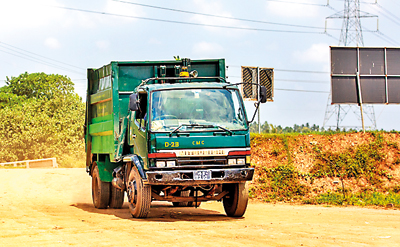Hamilton Canal is dead!
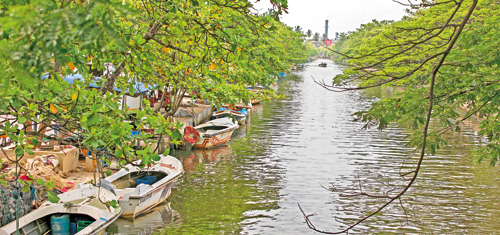
Hamilton Canal under threat. Pix by Sameera Weerasekera
Here and there, the skeleton of a fish bobs on the surface of the water, starkly white against the black or is found entangled in the grasses edging the bank. There are no birds because the fish and other crustaceans are dead. The water too is still, having taken on the colour of murky black, whereas earlier it had been flowing clear and transparent.
The Hamilton Canal is dead! Many blame it on a massive discharge from the Kerawalapitiya garbage dump run by the Sri Lanka Land Reclamation and Development Corporation (SLLRDC).
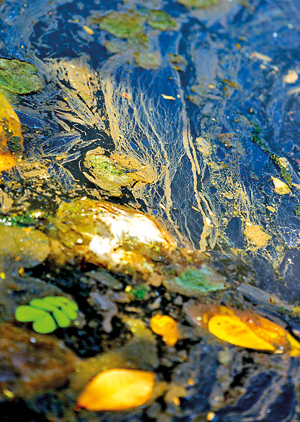
Dead fish floating in murky black waters
The mourners are many for the life-giving ‘artery’ that is the man-made Hamilton Canal which runs from Mattakkuliya, starting at the Kelani moya kata (the entry of the Kelani river into the sea) and flowing under the Palliyawatte-Dickowita-Uswetakeiyawa-Kadalawala-Mattampaduwa-Pulluhena-Indigaslanda-Pamunugama-Sedawatte Palamas (bridges), finally ending in the meegamu kalapuwa (Negombo lagoon).
The troubles had begun when the rains came about three weeks ago and many people living along the canal are stridently clear about what happened – the muck from the Kerawalapitiya garbage dump in Muthurajawela had got washed into the canal, leaving its waters thick black, with oily sedimentation settling on its bed, ringing the death knell for even the hardiest of creatures.
An urgent petition is being passed from home to home and activist Seebert Nanayakkara is hoping to collect at least 1,500 signatures.
The petition supported by the Catholic priest and the Buddhist monk in the area is appealing that the authorities study this crisis of the canal by getting experts to give an opinion and then take action to redress the situation immediately.
Referring to the starting point of the garbage-dumping issue, Seebert says that first the authorities wanted to bring the garbage to Pattiyawala in Uswetakeiyawa, then following major protests, they shifted their focus to Bopitiya and ultimately to Delatura but were pre-empted from doing so due to a court order.
Under cover of the security zone of Kerawalapitiya which is guarded, now the garbage is being dumped there, he said, adding that they will be sending the petition to the Gampaha Office of the Central Environmental Authority (CEA).
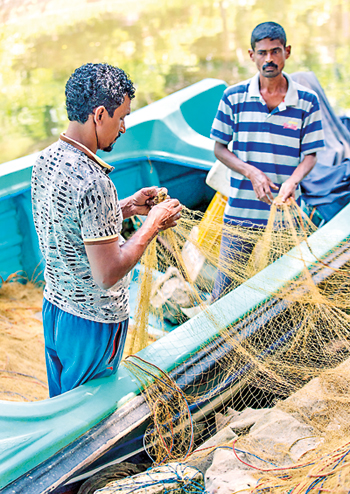
Sorting out nets without fish
With regard to the current canal crisis, first came a thel gathiyak (oily substance), says a small knot of fishermen tending their empty nets very close to the Pulluhena Palama, while boats in their numbers line the canal banks.
Pointing out the black water-mark clearly seen on the built banks of the canal, fisherman Tissa Jayamaha says that fish died in their hundreds, rotted and “bima giya” (got absorbed by the sedimentary canal-bed).
Recalling how as boys they would jump into the waters of the canal as soon as they returned home from school and everyone used to bathe here, take the water for cooking and also washing pots and pans, he says the trouble began about two years ago when factories and pig and poultry farms began channelling their waste. “Before that we did everything with the waters of the canal, only getting our drinking water from elsewhere,” says Tissa.
“Unique,” is the canal, he says, explaining how “udahata” (at the top) the gange wathura (river water which is fresh) mixes with the waters of the canal and “pahalata” (at the bottom) how the kalapu wathura (lagoon waters which are brackish) mixes with the canal waters. The brackish water acts as a natural disinfectant.
Just about three weeks ago, an unimaginable disaster has occurred killing all the fish, sighs Tissa who used veesi-del (throw-nets) to get a catch, with the others nodding vigorously. They believe the culprit is the run-off from the Kerawalapitiya garbage dump.
All the fish in the Hamilton Canal have died – they include korali, keba, thilapi, batto, pethiyo, even the very hardy karakuddu and also the prawns.
“Den mokakwath ne,” he says, pointing out that there is nothing left. A few robust ones like angulo which could escape to the lagoon did, but all the others died. “Okkoma merila.” (All have died)
The views we hear our similar all along the canal.
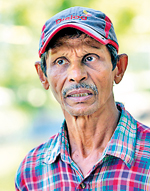
Tissa Jayamaha
Two to three weeks ago there was rain and that is when the trouble started, says Vijitha Kumara who lives close to the Uswetakeiyawa Meda Palama, lifting up a covering to show us “laksha ganaka del” (fishing nets costing several lakhs), now idling. His family too surrounds us and his son shows us the dark waters of a branch canal flowing just in front of their humble home.
Their home is close to the Kerawalapitiya garbage dump and Vijitha says that the kunu kande wathura elata berenna patan gaththa (the water from the garbage hill streamed into the canal).
Hamilton ela, kunu wuna, he says, stressing that the stench was unbearable and they were not able to stay in their home. It was as if a load of tar had been unloaded into the canal. Usually, if there is mild pollution, the process of wada-diya (high tide) and ba-diya (low tide) clears it up, but not this time.
This has never happened before, laments Vijitha.
| Water sent for testing: CEA and NARA | |
| The Central Environmental Authority (CEA) and the National Aquatic Resources, Research and Development Agency (NARA) have taken water samples for testing to scientifically determine what has caused the massive pollution of the Hamilton Canal, the Sunday Times learns.“When we got to know about the problem, my officers inspected the canal and collected water samples for testing to find out the pollutants. They also inspected the compost plant of the SLLRDC,” said the Acting Director of the CEA Gampaha Office, M. Sivakumar, adding that the report is due tomorrow.He reiterated that there is an urgent need to draw up a long-term rehabilitation plan for the canal, especially as new development projects are due to take place. Even by the time the latest issue cropped up, the canal was severely polluted due to many discharging rubbish into its waters.NARA Chairperson E.A.S.K. Edirisinghe said that on a complaint received a week ago, a team visited the area and also the waste-dumping site. They “physically observed” a black liquid oozing out of the dump-site and found that the treatment plant there had not been functioning. “Even though the team was told that the overflowing liquid was being channelled to a closed-circuit canal which was not connected to the Hamilton Canal and as such was not discharging waste into the latter, that canal seemed to be linked to the main canal,” he said, adding that the report will be ready next week. The NARA team had found that oxygen levels in the waters of the Hamilton Canal were low and was checking whether any chemical flowing into it was causing this problem, it is learnt.
|
| Kerawalapitiya, a temporary measure: SLLRDC | |
 A rising garbage dump in Kerawalapitiya We are checking whether there has been leaching from the garbage dumping yard at Kerawalapitiya, said SLLRDC Vice Chairman Aruna Gunawardena when contacted by the Sunday Times. Kerawalapitiya was a temporary measure taken soon after the Meethotamulla disaster in April 2018. The garbage is kept in piles here for the manufacture of compost, he said, reiterating that it was a “temporary” solution, when taking into account all factors including the environment. Mr. Gunawardena said that the permanent solution for garbage is the sanitary landfill at Aruwakkaru. “All the work is done there and we have been telling the Colombo Municipal Council to take their rubbish there in the last two-three months.” Meanwhile, SLLRDC’s Deputy General Manager (Drainage & Reclamation), S.P. Muthumala said that until the rains recently, there was no problem at Kerawalapitiya, since the garbage was sent there for about a year now. There is no leakage from the treatment plant, but the garbage which may have been stockpiled outside may have leaked into the canal with the rains, he said, adding that as a damage-control measure they had increased the volume of the plant.
|
| Garbage arriving from Colombo | |
| Lines of trucks with garbage from the Colombo Municipal Council and the Gampaha Municipal Council could be seen coming to the area, when the Sunday Times was there on Wednesday.This was while the giant-arm of a backhoe, in the distance, as we were not allowed to go near, could be seen pushing the garbage hither and thither.
|



